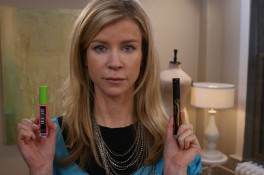
Old Make-up? Toss it!
We admit it. Like most women, we've got a stash of old cosmetics hiding in the back of a cupboard that we just can't bear to throw out. But even though most make-up doesn't have an expiry date, experts agree it definitely has a shelf life. And it may not last as long as you think!
The Basics
-
General rule of thumb: use all make-up products within 3 years of manufacturing, regardless of how long they’ve been open.
-
A recent trend in make-up towards natural and preservative-free products means many have expiry dates and much shorter shelf lives. Ask sales people about shelf life and make sure you’re ready to use the product up quickly.
Why Worry?
-
Using old make-up (or badly stored make-up) exposes your eyes, lips, and skin to harmful bacteria, microorganisms, yeasts, fungi and viruses.
-
For example, you can contract:
-
Eye infections from bacteria like staphylococcus include blepharitis (inflammation of the eye and eyelid), styes (a swollen bump at the base of the eyelashes), conjunctivitis (aka pink-eye, reddening and inflammation of the eye).
-
Skin infections like peri-oral dermatitis (little red bumps on the skin that look like acne).
-
-
Bottom line: don’t share make-up, and pay attention to shelf life! (See below.)
Best Before:
-
Here’s a list of typical make-up items and their shelf life:
-
Mascara and liquid eyeliner: 3- 6 months (though the FDA recommends 2-4 months)
-
Eyeliner and lip liner pencils: 3 years
-
Foundation, oil-free: 1 to 1.5 years
-
Foundation, creamy or compact: 1.5 to 2 years
-
Powder, pressed: 2 years
-
Powder, loose: 3 years
-
Concealer, liquid: 1 year
-
Concealer, stick: 1.5 years
-
Blush and eye shadow, powder: 2 years
-
Blush and eye shadow, cream: 1-1.5 years
-
Lipstick: 2 years
-
Lip gloss: 1.5 years
-
-
IMPORTANT NOTE: These guidelines are only good if the make-up is stored correctly. (See “Prevention” section below)
Time to toss it:
-
Even if your make-up hasn’t reached its expiry date or recommended best before usage time, it can still go bad. Use your eyes, nose, and common sense to determine whether you should use it.
-
It’s time to toss when:
-
Mascara becomes thickened or dried out. This usually happens due to the pumping action of the brush, which allows air (and other potential baddies!) into the tube.
-
Foundation (oil-free) separates and dries out. It will also start to smell “off”.
-
Powder becomes crumbly and dried up, and no longer goes on smoothly. Pressed powder may also become slippery due to mixing with your skin’s natural oils.
-
Concealer sticks dry out and pull at your skin when you try to apply, rather than transferring its creamy colour.
-
Concealer liquids separate and become lumpy.
-
Powder blush and eye shadow colours fade or change. This happens due to oxidation (exposure to air) and also exposure to light. The texture may become drier, or slipperier due to mixing with the skin’s oils.
-
Cream blush and eye shadow, which contain emulsions, start to separate.
-
Eyeliner and lip liner become dry, cakey, and don’t go on smoothly anymore.
-
Lipstick changes colour and feels dry and scratchy. (Note: if tiny drops of moisture appear on the surface, don’t worry. Just wipe them off.)
-
Prevention is key:
-
Even if your make-up is relatively new, it can still become contaminated if you don’t store it correctly. These guidelines can help you ensure you get the most out of your make-up:
-
Clean: always apply make-up with clean hands to a clean face. Keep applicators, lids, etc. from coming in contact with tables and counters. Use clean brushes, sponges, and applicator tools. Clean them with warm, soapy water and air dry, or replace completely, every week.
-
Keep dry: never add water, saliva, moisturizer, etc., as this will introduce bacteria, create a moist environment for bacteria growth, and also water down preservatives.
-
Keep cool: preservatives in make-up break down at high temperatures (e.g. 30C/85F or higher). Do not keep make-up in your car, and store it in a cool place at all times.
-
Beware of wands: mascara, liquid eyeliner, liquid concealer and some lip glosses are prone to contamination because the applicator is potentially exposed to bacteria and then reinserted into the liquid for storage, which is a prime breeding ground for bacteria.
-
Container properties: foundation and concealer in tubes, sticks or bottles with pumps only dispense a precise amount, whereas open pots or wide-mouthed bottles expose make-up to oxygen and potential bacteria.
-
Share not! Sharing increases contamination and can directly spread infection and viruses.
-
Sharpen often: regular sharpening of eye liner and lip liner pencils helps keep them free of bacteria.
-
Less is more: use only a few products at a time. (We know, it’s fun to experiment with lots of different things.) At least stick to one mascara only. The less you use, the sooner you’ll use them up before they expire, and the less risk of contaminating other products.
-
Irritated?
-
If you have an eye infection or constantly itchy eyes (not hay fever-related), toss all eye make-up immediately and sanitize brushes thoroughly (or replace) so that you don’t re-infect yourself.
-
If your skin reacts with bumps or itchiness, your blush, powder or foundation may be past its prime. If it’s new, however, you may instead be allergic to something in the product.











